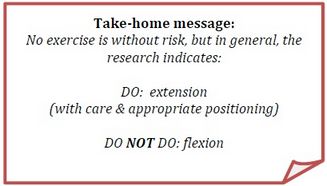Current Research on Vertebral Fractures: Implications for ADLs & Rehabilitation Copy
3.2.1 How do fractures develop?

Of course, development of vertebral fractures is not entirely that simple. Below is a possible explanation of the more complex process, derived from current research findings7,14,49:
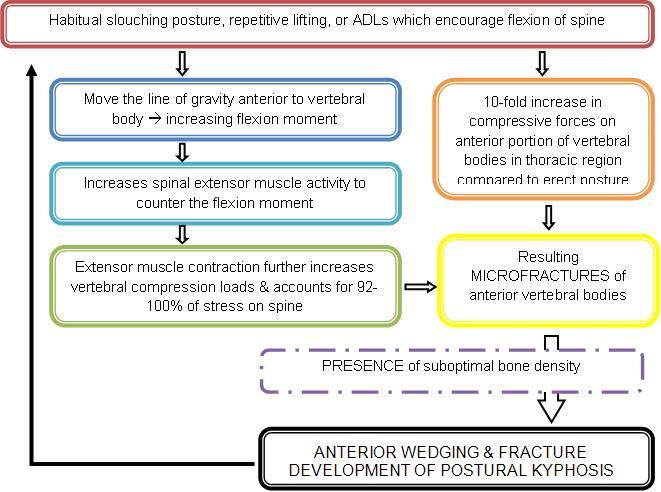
The development of thoracic kyphosis has many impacts on a person with osteoporosis. A few key research findings have been summarized below:
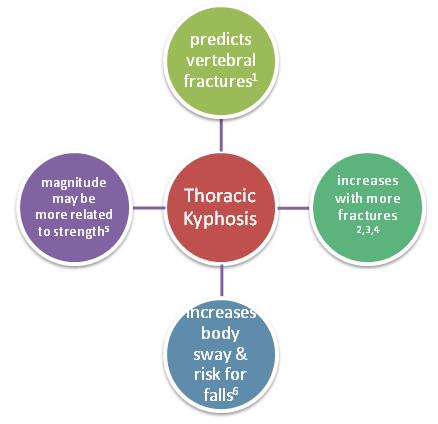
11-Briggs8; 2- Campbell10; 3- Cortet12,13; 4- Ensrud15; 5-Edmondston (1994); 6- Sinaki48
The current evidence appears to support the proposal that flexed postures & repeated flexion may result in adverse events like falls and fracture in people with poor vertebral bone quality.
3.2.2 Is There Evidence for Extension Exercises?
Laying the Foundation
In an early exercise study, Sinaki and Mikkelsen51, investigated the effects of 4 different exercise programs on small groups of postmenopausal women with spinal osteoporosis and back pain. Their results demonstrated that the group whose program emphasized lumbar extension exercises had significantly less spinal fractures compared to a similar group who performed flexion exercises, combined extension/flexion exercise or none at all. Although these results were promising, it is important to note that this was not a randomized controlled trial and the numbers in each group were fairly small.
Follow-Up Research
A study which included a 10-year follow up focused on the long-term effect that a two-year progressive resistance back extension program had on post-menopausal, healthy women. Their results revealed that compared to the control group at the 10-year follow-up, those women performing extension exercises had significantly less fractures, greater back extensor strength, than those women not exercising at all.50 Of note, both groups demonstrated similar decreases in BMD and increases in kyphosis at the 10-year follow-up compared to baseline. This study provided no information regarding randomization or allocation concealment and 23% of participants were lost to follow-up, so results should be interpreted with caution.
More Recent Work
Gold et al.,19 conducted a randomized controlled trial (modified cross-over) using 185 post-menopausal, older women with vertebral fractures. The intervention was a 6-month monitored exercise class & coping classes followed by 6-month of self-maintenance. Exercises included stretches to increase back extension, hip extension & shoulder flexion. Progressive strengthening exercises focused on back extensors, axial muscles groups (ie., traps), abdominals & hip muscles. Instruction on safe exercise, body mechanics for ADLs & optimal posture was provided. Ultimately, analysis of results indicated that the intervention group showed improvement in the outcomes of trunk extension strength during Phase I but it declined during the self-maintenance phase. The authors concluded that older women with vertebral fractures can improve trunk extension strength but that the sustainability of these gains are linked to continued intervention.
Hongo et al.,23 investigated the effect of low-intensity back extension exercises with an RCT involving 80 postmenopausal women with osteoporosis. The exercise group performed one set of ten repetition of a simple isometric back extension (from prone) daily. At the 4-month follow-up point, both groups had significantly increased their back extensor strength compared to baseline with a significant difference noted between groups as well. QOL measures improved significantly in the exercise group only. It appears that simple, low-intensity exercises can have a significant impact on both back extensor strength and quality of life.
Papaioannou et al.,41 conducted an RCT with 74 postmenopausal women with at least one vertebral fracture to determine the effect of a 6 –month home exercise program on quality of life. The exercise group completed a minimally supervised program including strengthening with resistance bands, stretching and aerobics (walking commonly) for 60 minutes, 3 times per week. At the 12-month follow-up, the exercise group had demonstrated significant gains in quality of life, with greater correlations of QOL gains found with higher adherence. Investigators reported no significant changes in bone density at the hip or vertebrae.
3.2.3 What About Changing Posture?
Briggs et al.,7,8 have stated in their research that it is important for therapists’ treatment plans to include specific strengthening modalities to reduce vertebral loading and that interventions aimed at minimizing thoracic kyphosis may do this.
Authors investigating vertebral bone failure under compressive forces have shown that recovery of cancellous bone height is possible following removal of forces17. The research was conducted in lab conditions with short-term compressive forces of very high loads to vertebral cancellous bone, with a resulting 94% recovery of bone height following removal of the loads. The authors suggest this recovery mechanism inherent with cancellous bone may be the key in allowing a damaged vertebrae/articular joints to regain original shape (and height!) with little loss of function. There hasn’t been conclusive research on long-term osteoporotic fractures with respect to potential recovery of vertebral height through a similar mechanism.
However, it would stand to reason that unloading activities such as active extension, postural correction and/or avoiding/adapting ADLs which are flexion-based, can reduce compressive loads which MAY prevent further fractures.
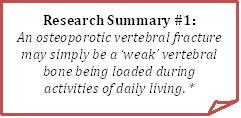
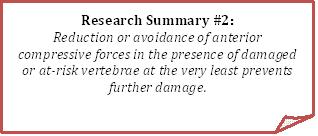
3.2.4 What Do We Know about Exercise After Vertebral Fractures?
- The nature of “best exercises” still remains unclear
- Improvements in back extension strength, psychological symptoms, QOL have been noted
- These exercises may improve balance
- Improvements in pain is not a strong finding
- A trend towards improvement in vertebral morphometry has not been demonstrated strongly
(Gold19, Malmros33, Papaioannou41, Webber53, Hongo23)
Adverse Events HAVE been reported during these programs
- Fractured costal cartilage during prone exercise
- Fractured rib while rolling from supine to prone
- Metatarsal fracture when 2lb weight fell on foot
- Hip fracture after 6MO physical examination
- Soft tissue pain (neck, back)
- Back pain, unspecified – 2/3 returned to exercise
- Pain during exercise, fall concerns (14/74)
(Gold19, Hongo23, Papaioannou41)
